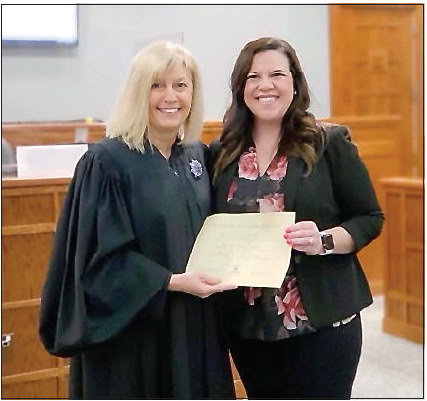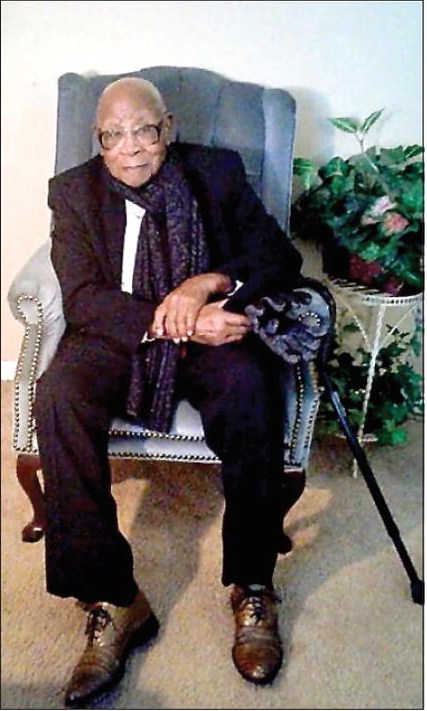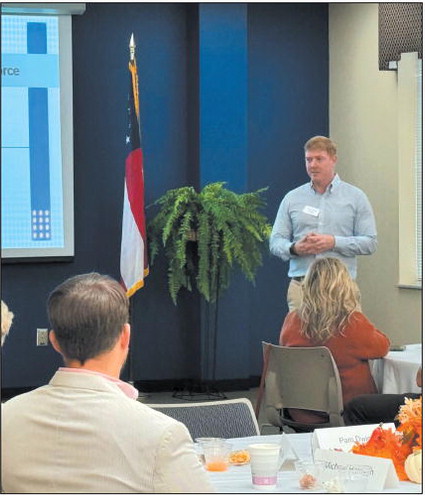continued from page quite a ….


continued from page
quite a large hospital for a community this size.” His second thought was, “They are going to need a new one sometime soon.”
In 2000, Meadows Hospital was almost 40 years old. “Aging health care facilities and modern medicine don’t match up,” Kent said, explaining that it is very difficult to transform a facility built in the mid-20th century into the flexible type of environment with the large pieces of equipment, traffic flows and patient requirements existing in the 21st century. “That is why you saw a lot of hospitals in this country being replaced (in the early 2000s). The life cycle of a hospital is 40 years and we were right up on that. It was time to start thinking about a new one.”
Kent allowed, “We needed more circulation space and we were landlocked in the old location; there was not enough room to expand.” The original plan was to try to utilize parts of the old facility, build a new hospital, and over a period of time transform. “We brought in engineers to do feasibility studies, but basically, they indicated our best bet was to find a new site and to build a new facility,” Kent recalled.
Built as a federallyfunded Hill Burton hospital and opened in 1963, Meadows Hospital was named in honor of Dr. John M. Meadows, the first physician in Toombs County. It was built on donated land, subsidized with grants and contributions, and invigorated by a lot of community support.
Before Meadows, there were several, physicianowned facilities in Lyons and Vidalia, including the Gross-Mercer Hospital. In the 1980s as hospital payments changed from cost-based to prospective payment-based platforms, hospital beds all over the country emptied out and hospitals got smaller and many closed. At Meadows, 35 beds were converted to a skilled nursing facility that became Meadows Nursing Center. By that time, Meadows had expanded several times, but as Kent observed when he came on board in 2000, changes had to be made to create opportunities for upgrades in medical services.
“We had a ton of growth in the hospital between 2000 and 2010. The thing about Vidalia was that we had really excellent doctors here who had great reputations and delivered quality results, but we did not have a wide range of specialty medicines,” Kent said.
Toombs County is a regional hub for several surrounding counties with a concentrated population in Vidalia and Lyons. “We knew (part of the area population) was going elsewhere to see specialists. We wanted people to get quality care right here instead of going outside our service area.” To support the physician base already established in Toombs County, Meadows started recruiting cardiologists, urologists, general surgeons, ENTs, pulmonologists, additional obstetricians and gynecologists, and others.
Kent explained that the growth of the medical staff and the hospital established the need for a new medical facility. “As we added medical specialists and invested in new technology, we started outgrowing the old facility,” Kent said, adding, “And, along the way, we built the wellness center. It was a great step toward building a new hospital. It gave the community a taste of preventive and rehabilitative medicine.” The Meadows Health Wellness Center housed a physical therapy component and fitness center. “We began drawing people into Meadows with auxiliary services. Physicians began keeping more patients here. These innovations earned Meadows more respect in the community,” he said. The purpose and commitment of the community facility evolved. “We had regional in our name, but over time we became regional in our reach.”
Financed with a guaranteed loan from the Department of Housing and Urban Development—and without local tax proceeds or grants—the new $75 million Meadows hospital opened in 2011. Soon, innovations in oncology and cardiac medicine came along. A heart catheterization component was added, and an oncology program developed, ultimately resulting in a new cancer treatment center. Meadows came to be recognized as one of the more sophisticated rural hospitals in the nation thanks to its physicians and technology; in fact, Newsweek counted Meadows as one of the best maternity hospitals in the U.S., Kent said.
The communityowned, not-for-profit facility was growing and thriving, but across the country, the dynamics of health care were shifting. “Hospital consolidation is a reality of the world these days,” Kent said, pointing out that rural hospitals are in even more peril than the average community hospital. Almost 200 rural hospitals closed since 2005 and over 100 since 2010. Around 2015, local hospital officials began to evaluate the long-term projections for the facility, and in 2017 a consultant was hired to help with an objective analysis of the facility’s strategic options.
“When we started looking around, it became clearer how unusual we were in our rural location. A University of Georgia economist who did a study for us a few years back found at that time Meadows was the most isolated community hospital with respect to cardiac care in the state. It was 90 miles in any direction to the next tertiary care hospital.”
He observed, “We had to ask ourselves what we could do to offer the best opportunity to have a hospital operating 50 years from now at least at the level Meadows operates today.”
Kent pointed out that by 2020, revenues at Meadows were declining and projected to continue to decline. “COVID made almost every hospital in the nation unprofitable during 2020, and there is uncertainty as to how it will affect long-term viability. All these factors drive consolidation in industry. Most hospitals in Georgia already belong to a system because of the power of scale. It is very difficult for any independent hospital to remain so for much longer.” He reinforced his point. “Anybody that is following the industry has seen the marked transformation of health care over the last 20 years. Hospital care is extremely expensive. If you look at the percentage health care consumes of the gross domestic product, we will be to 20 percent before long. That is absolutely unsustainable.”
A three-year search determined that HCA was the best option for Meadows, and in March, 2021, HCA bought Meadows Hospital and most of its assets for $73 million. The sum was less than what it cost to build Meadows, but was still considered a good deal because of Meadows’ declining profits. The sale agreement was approved by the Secretary of State’s Office after public hearings since Meadows was a community-owned, not-for-profit facility. HCA agreed to assume the hospital’s existing HUD debt of $52.8 million in its entirety. Net proceeds after the assumption of the debt were expected to be $30 million. These funds are to be managed by a newly-created Meadows Foundation, a not-for-profit organization that will directly benefit the community. Kent said that $10.3 million will be placed in escrow against potential future liabilities. In addition to the purchase price, HCA has committed to capital expenditures of at least $10 million over the five-year period following closing. Becoming a part of the HCA health care system made sense for Meadows, Kent said. “We have especially been supported by Memorial Health in Savannah (owned by HCA), our state designated trauma and peri-natal center. Over 80% of our transfers for higher levels of care already go to Memorial.” Being part of a regional health care team can provide a network of services. “We especially see strength in patient care management systems, purchasing at the highest levels and integrated information systems and electronic health records. There is group synergy from having a lot of people working on the same issues.” When it was purchased by HCA, Meadows was an organization with $130 million of net revenue. An individual piece of equipment can cost up to $1.5 million to $2 million and an upgrade to an electronic health record can cost up to $15 million to $20 million, Kent said, adding, “Those things quickly become beyond the capability of any stand-alone organization. The economies of scale that come from partnership enable you all to be better together because you can share overhead and resources.”
Kent opined, “I have always said that people should not get poorer quality health care because of where they live. But often, your zip code does determine the level of health care you get.” While Meadows was still in a position of strength, it was the right time to find a new partner. “We considered several options, including merging with other not-for-profits.”
Kent observed, “Looking back, I love how we went through this process. Our board managed this in a textbook manner. They approached it at the right time. They evaluated past and current financials and operation projections about the future, they did due diligence about options and developed a missiondriven set of criteria.” Kent added, “It was never about the money, it was not about how big we get to be, it was about the mission of serving patients in the region we take care of. It was about protecting that mission for the long term.”
Although HCA comes in as a for-profit operator, they are mission driven, Kent emphasized. “As it turns out, the lines between for-profit and not-for-profit have been blurring over the years because a not-forprofit that is not financially accountable will fail,” he said, adding that a for-profit that is not community driven will fail. “The real line between them is that a notfor- profit does not pay taxes and a for-profit does. Those taxes are going to support this community for many years to come.” Kent’s Career in Hospital Administration: HCA Bookends The negotiations that resulted in the sale of Meadows were not Kent’s first encounter with HCA. During his career, he actually worked for the corporate giant in its early days. After earning an undergraduate degree from Tech, Kent pursued a master’s degree in health administration at Georgia State College in Atlanta. As part of that degree program, Kent participated in a ninemonth residency at a 400bed facility in Bellville, Illinois. He actually ended up spending two years at that facility where he learned about hospital operations. Following this experience, Kent joined a relatively new health care organization called Hospital Corporation of America, which had been founded in 1968. He was assigned by HCA to different roles in several states before joining another company and moving back to Georgia, his home state, and starting his own consulting business. Kent has spent about 40 years in the hospital business. His first job in health care was as an emergency room clerk in his hometown of Griffin in 1979. He worked nights and weekends while earning his undergraduate degree. “HCA has furnished the bookends to my career,” Kent said. “My career pretty much started with HCA, and I became an HCA CEO at end of my hospital business career.”
One of the biggest challenges Kent has faced as a hospital administrator happened in 2020 with the international health pandemic. “It was one of the strangest and most stressful experiences of any of our careers and one we hope we will never repeat.” During the pandemic, Kent recalled facing the daily reports of COVID admissions and the patient census, which reached capacity in mid-summer of 2020. It would the spring of 2021 before the “double zeroes” were achieved when there were no in-house COVID patients and no new COVID admissions. “It was the natural progress of the pandemic,” he said, noting, “I was so proud of our Meadows teams who were right at the forefront. When everyone else was staying home and sequestering, they came out at great risk and put their own lives on the line.” Kent said the staff stayed on top of the latest technology and information and applied it in Meadows’s approach to treatment, which included negative pressure treatment that is regarded as one of the best standards for caring for COVID patients. Because it was a relatively new facility, Meadows already had several negative pressure rooms, but with a little design work, the facility was able to set up several negative pressure units.
“We got low on some things, but were never ran out of PPE for staff and doctors. We had more than enough respirators. We were one of the best positioned hospitals in the state with regard to facility and ventilation equipment,” Kent said. “It was a blessing that our board had the foresight to build a new facility and recruit physicians which stood as the front line against COVID in this community. I think it saved countless lives.” Kent has retired from his role at Meadows, but he is not planning on abandoning his work in health care. “I feel like I am a little too young to retire from everything. I will probably do some consulting down the road.” He observed, “But this became such a natural point for leaving my job here, of having shepherded the hospital through a 3-year process to find a strategic partner and organize a change of ownership. “ Kent and his wife now plan to relocate to her home state and take a little time off during the summer. “I have always been drawn to hospitals,” he said of the path he chose, offering that, ironically, there are no other health care professionals in his family. “I feel so blessed to have worked in hospitals. I love working in this environment.” He observed that the role of a hospital CEO means being a player on the greatest of teams. “It is rewarding every day. It doesn’t matter what job you have in a hospital, from employees who do the billing, to maintenance, to the medical staff, people’s lives are better because of the work you do every day. This is a role of stewardship and I hope I have been a good steward, but it is time to hand off to the next generation.” Kent insisted that his success is shared with the communities he has served. “The success we have had here likely could not have happened in any other community. The civic and volunteer organizations, the churches, the community leadership made it possible. I really believe our hospital board was a north star and had the courage to make the difficult but right decisions to ensure the hospital’s continued growth.”






